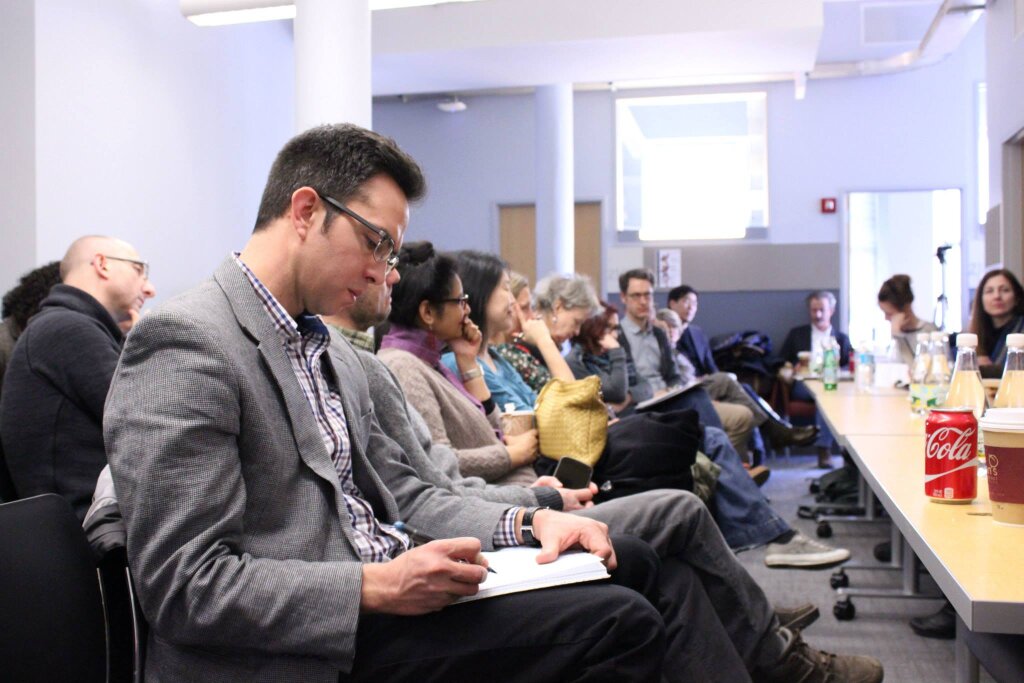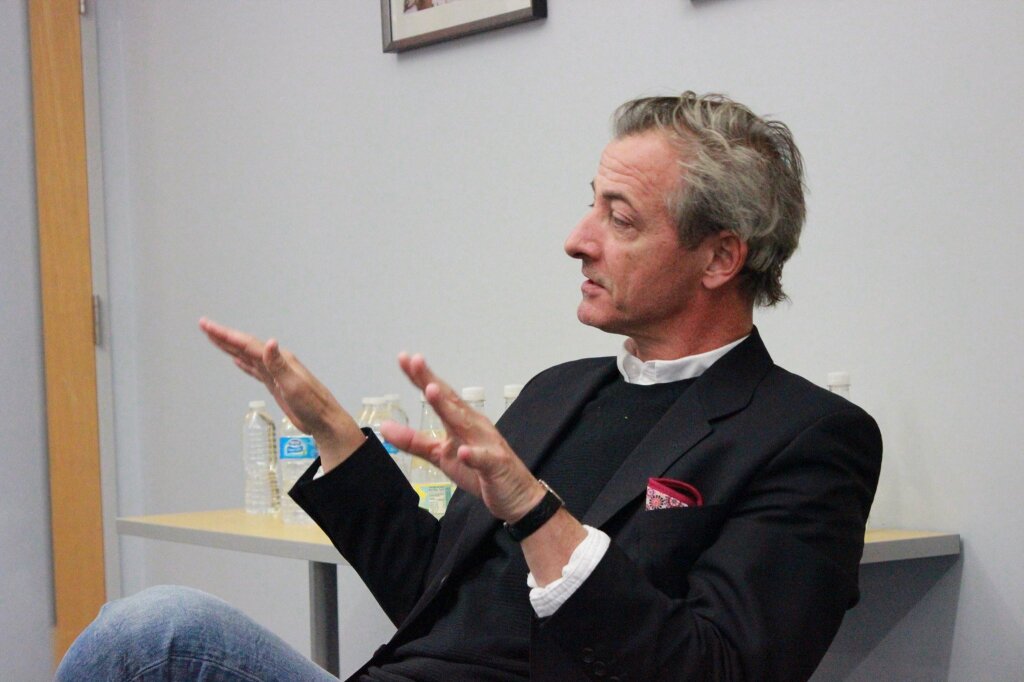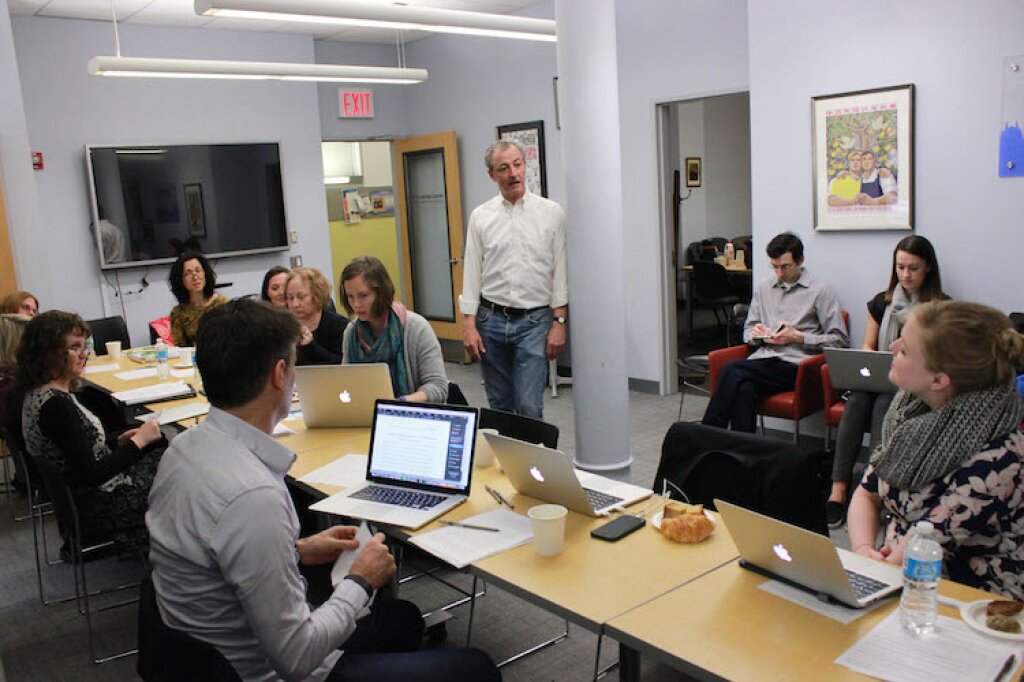Watch the video of Panel 4 here
Watch the video of Panel 5 here
Watch the video of Panel 6 here
Watch the conference conclusion here
On February 27, 2015 the NYU Jordan Center for the Advanced Study of Russia hosted the second part of its two-day workshop Russia’s Races: Meanings and Practices of Race in Imperial Russia and the Soviet Union, convened by David Rainbow, a postdoctoral research fellow at Columbia University’s Harriman Institute for Russian, Eurasian, and East European Studies, and co-sponsored by NYU Department of History, Global Research Initiatives (NYU Provost), the Harriman Institute, and the Humanities Initiative (NYU).
Check out our report from Day 1
Panel 4 | Colonial Tourism
The fourth panel saw Chia Yin Hsu, a historian from Portland State University, present her paper “Russian Resorts and European Leisure: Railroad Vacations, ‘Native’ Sights, and the Making of a Russian (Post-)Colonial Identity in Manchuria, 1920s-1930s” and Edyta Bojanowska, a scholar of Russian and Slavic literature from Rutgers University, discuss her study “‘Diverse Groups of Varicolored Bodies’: Race in Ivan Goncharov's The Frigate Pallada (1858).” Caterina Pizzigoni, a historian of Early Modern Latin America from Columbia University, served as discussant.
Hsu’s intervention focused on her study of Russian tourism to Manchuria following the establishment of various health resorts along the Chinese Eastern Railway through ethnographic writings and memories of the Russian visitors, who often described the resorts in fond terms. She noted how the Russian experience in Manchuria from the 1920s was tied to the context of transformation “from a regime of privilege to a regime of access” through the democratization of holiday travel and leisure taking place across Europe. In the Manchurian case, however, leisure was a regime of both access and privilege. “The conjoining of these two regimes is what led me to my exploration of race,” Hsu said. Travels to the region brought the Russian population in contact with the indigenous population, and at the same time contributed to the definitions concepts of Europeanness/whiteness and indigeneity as mutually dependent, thus conveying a new sense of Russia never known before. Hsu argued that the category of race is strongly intertwined with other categories, such as gender, class and ethnographic knowledge.
Bojanowska started her presentation showing the itinerary followed by Russian novelist Ivan Goncharov after joining a Russian expedition through Africa and Asia in the 1850s. Goncharov’s travel notes – later published in a book titled The Frigate Pallada – is the starting point for her investigation of “the global imperial world of which Russia is part.” Bojanowska stressed the necessity of going beyond scholarly discourse in discussions of race and examine the role of popular culture – and travel literature in particular. While being extremely popular in Russia (The Frigate Pallada was more popular at the time than Goncharov’s masterpiece Oblomov), travel accounts were also often read by the early pioneers – thus playing a double role in propagating specific racial notions while also informing them. Bojanowska noted how the travelogue – with its “lower races often animalized and debased” – fits perfectly in the mainstream of European discourses of race. Surprisingly, the book was in later years pointed to as a prime example of Russian humanism and tolerance.
Pizzigoni noted how both papers problematized the notion of Russian exceptionalism by drawing parallel with similar dynamics in play elsewhere in Europe. She also questioned the role of the church in the Russian civilizing mission, observing how religion played a fundamental and multilayered role in the case of Latin America. Pizzigoni drew attention to the predominantly biological aspects in the discourses of race described in the panelists’ works and praised the paper for the focus on miscegenation.
Pizzigoni’s comments were followed by a lively discussion that allowed the panelists to delve deeper into questions such as the role of the Russian Orthodox Church in the colonial context, the issue of self-censorship in travel accounts and the problematic identification of Russia as a European power.
Panel 5 | Practices and Theories
This panel revealed the fluidity of the term “race” and questioned the multiplicity of its definitions and functions. It also addressed the difference between how race is acted vs. how it is talked about.
Nathaniel Knight, a historian from Seton Hall University, proposed to put aside the “toxic” terminology of race and to look at its various functions in his paper “What Do We Mean When We Talk About Race? Methodological Reflections on the Theory and Practice of Race in Imperial Russia.” He suggested that race is always located in the realm of power – often in top-down power: it aids social mapping by instilling order and governability.
In the Russian context, Knight continued, the concept of race certainly existed. But how useful was it for people to understand the world around them? He proposed that while in the US the long lasting legacies of unfreedom were defined by racial relations, in Imperial Russia, it was the sosloviia (social category measured by its proximity to power) that established these legacies.
Knight then addressed the difference between race and ethnicity and made a plea “to keep the body in race.” For if the biological attribute of race was removed from its definition, then what would distinguish race from ethnicity?
In the question and answer period, Knight’s suggestion to assert that when we speak about race we are speaking about biological and physical distinctions provoked a lot of critical comments. Several people in the audience wondered why it is so important to draw such rigorous distinctions between race and culture. Knight himself asserted in his talk, that this universalist position is dangerous because it leads to deterministic thinking. However, he also stated that it is the job of a comparativist historians to draw out distinctions and particularities, and the category race is one way to do that. A comment from the audience suggested that Knight’s argument reveals that race, ethnicity, and nationality are all socially constructed concepts at the end of the day.
Alaina Lemon, an anthropologist from the University of Michigan, questioned how race affects various realms of experience in her paper “The Matter of Race.” She wanted to think of race as it is tied to the daily life and materiality. In order to reach some meaningful conclusions, Lemon compared racial dynamics in the US and the USSR. In the US racial segregations establish divisions and “blackboxing” on the level of material experience and communication; while many people in the US experience extreme poverty, others are completely unaware of it. Similarly, Lemon suggested that the racial segregation in the US makes censorship almost unnecessary: “why do we need to censor, if we can filter voices first?” Traditionally, race as a concept does not exist in the USSR. For example, some argue that race does not segregate people on the level of materiality: each person in the Soviet Union was aware of and exposed to poverty. Nevertheless, the Roma community living in the USSR were experiencing the same form of segregation as African Americans in the US.
The panel’s discussant, Aisha Khan, an anthropologist of the Caribbean and Atlantic World at NYU, suggested that Knight’s paper is correct to point out the slipperiness of the term “race.” She also proposed that race can lead to bottom-up dynamic and has a potential for reasserting racial equality. In response, Knight stated that there are various ways to exercise power. Power can be discursive and symbolic. For instance, creating groups and categories, while making distinctions is also an exercise of power. Creating terms and contesting their meaning is another example. In Khan’s opinion, Lemon’s paper interestingly reveals that racism has its modes of censorship and that class has its own modes of racialization.
The ensuing discussion addressed topics of race vs. ethnicity, biology vs. culture, as well as a comparison of Russian serfdom and American slavery.
Panel 6 | Distant Connections
The sixth panel looked at the globalized dynamics of race and ways in which racial identities are forged. Both papers reiterated that the concept of race in literary language and philosophy, as well in bureaucratic discourse in Imperial Russia and Soviet Union did not really exist as a category. Yet, certain instances of racial identities are apparent.
Susanna Soojung Lim, literary scholar at the University of Oregon, focused on the concepts of PanMongolism in Russia, Asia, and Europe in the writings of several prominent intellectuals in Russia and Korea in her paper entitled “’Delightful Lure’: Imagining Racial Solidarity in Solovyov’s PanMongolism and Yun Ch’iho’s Pan-Asianism.” “Is PanMongolism a real phenomenon?” Lim asked. It was not until the late 19th century, that the racial category of PanMongolism entered the realm of literature and philosophy in Russia in the writings of the Symbolists and Vladimir Solovyov. While previously, the divide between East and West from within Russia was seen as the divide between Eastern Orthodoxy and Western Catholicism, by 1890s the East/West divide is defined by Europeanized Russia and PanMongolism. Vladimir Soloviev’s categories changed when he encountered a Westernized Chinese man on his travels to Europe. He was struck by this encounter as it challenged the immutable notion of race. Later, he also conflated Chinese and Japanese cultures into one “yellow race.” Panmongolism as a category in Asia also arises around the same time – as a response to European dominance – and is therefore considered by Lim as a modern phenomenon.
Anika Walke, historian from Washington University, St. Louis, discussed the experience of African students who were studying in the Soviet Union in the 1960s in her paper "Was Soviet Internationalism Anti-Racist? Toward a Social History of Foreigners in the USSR." How did they experience the Soviet Union? How did the Soviet authorities facilitate their conditions? And what was the response of Soviet citizens to these students? Race as a category did not exist in the discourse of the official institutions in the USSR at the time. Racism, by definition could not exist within a socialist country, because it was a by-product of capitalism and imperialism. Yet, despite the Soviet state’s insistence on internationalism, Walke asserted that foreign students experienced certain hostility from the people around them. Could this hostility be explained by the fact that they received more privileges from the authorities? Walke also suggested that foreign students did indeed experience racial prejudice, which led her to conclude that there is the dynamic between the “other” from the Soviet republics and the “other” from a foreign country is strikingly different.
The panel’s discussant, Gunja SenGupta, historian of the US from Brooklyn College, wondered how Lim’s argument reveals ways in which nation-states develop ideas of race by means of internationalism. For instance, in the beginning of the 19th century, there began a transpacific dialogue about Asians as peril. Therefore, the Japanese Imperialism caused anxiety not only in Europe, Russia, but also North and South Americas. The “yellow peril” was therefore globalized. In response to Walke’s paper, the discussant wondered whether the prejudiced attitude towards the African students by the Soviet citizens was symptomatic of inherent grudges against foreigners in general or against a racialized and privileged group.
The discussion following the presentations touched upon issues of various types of internationalisms in the USSR (global vs. domestic), Russian idea of “whiteness,” religion and race, as well as various types of methodologies when dealing with questions of race.
Conclusion
In the concluding discussion, participants addressed the study of race in various periods in Russian history. For instance, it was observed that all papers show that the study of race is better developed in Imperial Russia than the Soviet Union. In response to this, Rainbow stated that in 2002, the relevance of the concept of race to the Soviet Union was controversial. Now, however, many scholars are working on questions of race in the USSR. Race in the post-Soviet period also remains a rich subject for study. Even now, Russian officials still claim that racism as a category does not exist.
Additional reporting by Ilaria Parogni



